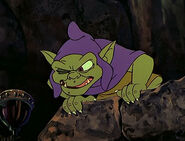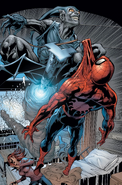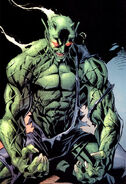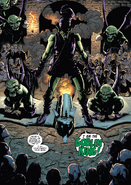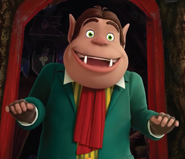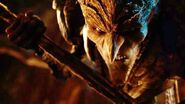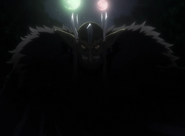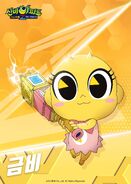- "How have you creatures not been wiped out?!"
- ― Minmax to the Goblin Adventuring Party (Goblins: Life Through Their Eyes)
The power to use the abilities of goblins. Variation of Demonic Fairy Physiology and Mythic Physiology. Not to be confused with Hobgoblin Physiology.
Also Called[]
- Drow/Dtrow/Trow/Trowe Body/Form/Mimicry/Physiology
- Gobblin/Gobeline/Gobling/Goblyn/Goblino/Gobbelin Body/Form/Mimicry/Physiology
- Goblin Body/Form/Mimicry
Capabilities[]
User with this ability either is or can transform into a goblin (also gobblin, gobeline, gobling, goblyn, goblino, and gobbelin, feminine: Goblette, plural: Goblettes), a small, ugly creatures who tend to be evil, crabby, and/or mischievous. While they're small and weak, goblins may make up for this by being clever and cunning. They may manufacture clever traps to trip up the unwary foe or overwhelm them through sheer numbers. Either way, goblins in folklore and fantasy fiction are highly variable lot in both appearance and behavior. Generally speaking, they are smallish humanoids, with pointy ears and features tending to pop up repeatedly.
A stronger form of goblin (which may or may not be conflated with the orc) may be known as a hobgoblin, though the term originally denoted the friendlier variety of goblin (the word 'hob' being derived either from the shelf at the back of a fireplace and thus indicating 'hearth and home' or from a Middle English nickname for "Robert"). English Puritans later started using the word 'hobgoblin', originally meaning a friendlier variety of goblin, to mean 'demon', which probably is why Tolkien used the word 'hobgoblin' to mean 'a bigger goblin'. This usage of the word was then propagated, by Dungeons & Dragons. While annoying, goblins are also more likely to be comedic, bumbling, or simply harder to take seriously than their bigger relatives.
A more recent trend in modern fantasy is to make them a merchant race with a unique gift for managing your money or separating you from it. Another trend tends to give excessive interest on fire and explosives.
In folklore, goblins and especially hobgoblins were diminutive household pests, or at best wild creatures, and were typically conflated with whatever trolls and/or faeries fit the trope. If they were viewed at all as a mythical race, instead of just monsters or diminutive faeries of the nasty sort, they would be generally viewed as the "dark" version of elves or dwarves in that culture.
Applications[]
- Accelerated Aging (Varies)
- Horn Protrusion
- Peak Human/Enhanced/Supernatural Condition
- Peak Human/Enhanced/Supernatural Body
- Peak Human/Enhanced/Supernatural Agility
- Peak Human/Enhanced/Supernatural Dexterity
- Peak Human/Enhanced/Supernatural Durability
- Peak Human/Enhanced/Supernatural Endurance
- Peak Human/Enhanced/Supernatural Health
- Peak Human/Enhanced/Supernatural Reflexes
- Peak Human/Enhanced/Supernatural Senses
- Peak Human/Enhanced/Supernatural Speed
- Peak Human/Enhanced/Supernatural Stamina
- Peak Human/Enhanced/Supernatural Strength
- Peak Human/Enhanced/Supernatural Combat
- Peak Human/Enhanced/Supernatural Mind
- Peak Human/Enhanced/Supernatural/Absolute Thievery (Varies)
- Peak Human/Enhanced/Supernatural Body
- Trapping Mastery
- Super Fecundity
Types of Goblins[]
- Boggart Physiology
- Bwbachod Physiology
- Genie Physiology
- Glashtyn Physiology
- Hitotsume Kozo Physiology
- Hobgoblin Physiology
- Kappa Physiology
- Kitsune Physiology (Sometimes called Goblin foxes)
- Knocker Physiology
- Kuri Physiology
- Redcap Physiology
- Tatty Bogle Physiology
- Tengu Physiology
- Trotterkopf Physiology
- Pukwudgie Physiology
- Yara Ma Yha Who Physiology
Variations[]
- Decelerated Aging/Longevity/Semi-Immortality
- Explosive Proficiency
- Flammable Blood
- Goblinoid Magic
- Supernatural Crafting/Impossible Forging/Meta Crafting (Varies)
Associations[]
- Bogeyman Physiology
- Classic Monster Physiology
- Dark Elf Physiology
- Demonic Fairy Physiology
- Gremlin Physiology
- Imp Physiology
- Mythic Physiology
- Orc Physiology
- Pukwudgie Physiology
- Trickster
- Troll Physiology
Known Users[]
See Also: Our Goblins are Different, Goblin Works, and Goblins.
Anime/Manga/Aeni/Manhwa[]
- Goblins (DevilUp)
- Goblin King
- Goblimon and variants (Digimon)
- Goblins and variants (Goblin Slayer)
- Goblins (Iron Knight)
- Teppei Ushizume/Iron Knight (Iron Knight)
- Kollekio (Marchen Awakens Romance)
- Goblins (Overlord)
- Goblin Troop (Overlord)
- Goblin Army (Overlord)
- Goblins (Re:Monster)
- Goblins (The Haunted House/Shinbi Apartment)
- Goblins (That Time I Got Reincarnated as a Slime)
- Gouvekan (Is There a Problem If the Demon King Is a Goblin?!)
Folklore/Mythology
- Goblins (European Folklore)
- Nunu sa Punso (Filipino Mythology)
- Trows (Orkney/Shetland Folklore)
Literature
- Goblins (City of Devils)
- Goblins (Demon Accords)
- Goblins (Discword)
- Goblinoids (Forgotten Realms)
- Goblins (Harry Potter)
- Krill Goblins (Karsearin: Adventures of a Red Dragon)
- Goblins (The Spiderwick Chronicles)
- Goblins (Thea Stilton: The Secret of the Fairies)
- Goblins (Tolkien)
Movies
- Creeper (The Black Cauldron)
- Goblins (The Hobbit: An Unexpected Journey)
- Goblins (Labyrinth)
- Goblins (Legend)
- Blix
- The Oomps (Little Nemo: Adventures in Slumberland)
- Norman Osborn/Green Goblin (Spider-Man: Into the Spider-Verse)
- Goblins (Onward)
Cartoons/Comics[]
- Aziz (Aladdin: The Animated Series)
- Goblins (American Dragon: Jake Long)
- Morris (Sofia the First)
- Goblins (Strange Magic)
- Goblins (Trollhunters: Tales of Arcadia)
- Grundles (My Little Pony)
- Kebi (Spookiz)
- Goblins (The Legend of the Three Caballeros)
- Goblins (Marvel Comics)
- Green Goblin (Earth-616)
- Gray Goblin
- Hobgoblin
- Demogoblin
- Harold Osborn/Hobgoblin (Marvel Comics); Ultimate Marvel only
- Norman Osborn/Green Goblin (Marvel Comics); Ultimate Marvel only
- Harold Russell/Goblin-By-Night (Marvel Comics)
- Norman Russell/Goblin-By-Night (Marvel Comics); formerly
Tabletop Games[]
- Goblins (RPGs)
Video Games[]
- Goblin Cookie (Cookie Run)
- Borogoblin (Medarot 5)
- Goblins (Miitopia)
- Naknada (Mortal Kombat)
- Goblins (Terraria)
- Goblin Invasion enemies
- Goblin Tinkerer
- Bokoblins (The Legend Of Zelda series)
- Moblins (The Legend Of Zelda series)
Web Comics/Series/Originals[]
- Ellie Half-Gob (Summoned Hero Hunter)
- Various Goblins (By the Book)
- Rath
- Various Goblins (Goblins: Life Through Their Eyes)
- SCP-2523-1 - Goblin Market (SCP Foundation)
- Redcloak (The Order of the Stick)




